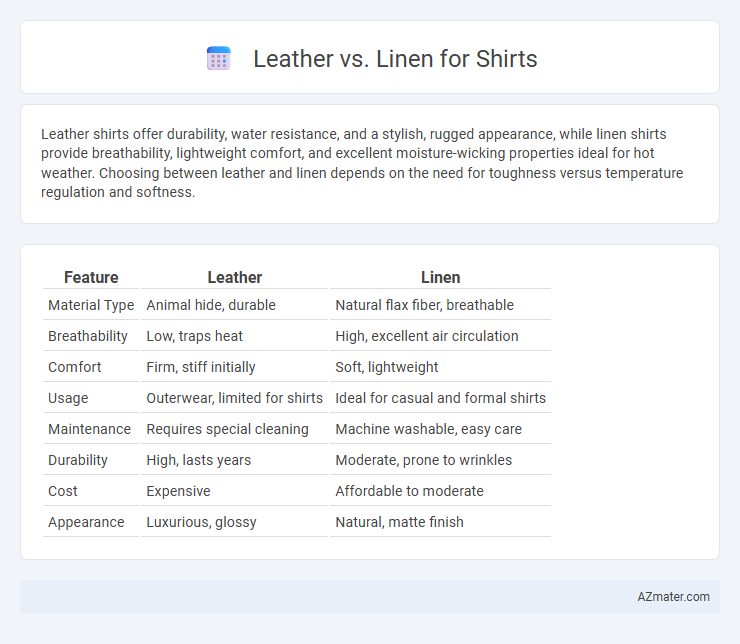Leather shirts offer durability, water resistance, and a stylish, rugged appearance, while linen shirts provide breathability, lightweight comfort, and excellent moisture-wicking properties ideal for hot weather. Choosing between leather and linen depends on the need for toughness versus temperature regulation and softness.
Table of Comparison
| Feature | Leather | Linen |
|---|---|---|
| Material Type | Animal hide, durable | Natural flax fiber, breathable |
| Breathability | Low, traps heat | High, excellent air circulation |
| Comfort | Firm, stiff initially | Soft, lightweight |
| Usage | Outerwear, limited for shirts | Ideal for casual and formal shirts |
| Maintenance | Requires special cleaning | Machine washable, easy care |
| Durability | High, lasts years | Moderate, prone to wrinkles |
| Cost | Expensive | Affordable to moderate |
| Appearance | Luxurious, glossy | Natural, matte finish |
Introduction: Comparing Leather and Linen Shirts
Leather shirts offer durability, a distinctive texture, and a bold fashion statement, often favored for their rugged and edgy appearance. Linen shirts provide breathability, lightweight comfort, and moisture-wicking properties, making them ideal for warm weather and casual settings. Choosing between leather and linen depends on factors like climate, style preference, and intended use, with leather suited for cooler climates and linen for hot, humid conditions.
Fabric Overview: Leather vs Linen
Leather offers a durable, heavy, and water-resistant fabric ideal for jackets and outerwear, while linen is a lightweight, breathable textile favored for warm-weather shirts. Linen's natural fibers provide excellent moisture-wicking properties and a textured appearance, making it a preferred choice for comfort and ventilation. Leather requires more maintenance and is less breathable compared to linen's ease of care and superior airflow, influencing their suitability for different climates and uses.
Comfort and Breathability
Leather shirts provide a distinct style but often lack breathability, making them less comfortable for extended wear, especially in warm weather. Linen shirts excel in comfort and breathability due to their natural fibers, which allow air circulation and moisture absorption, keeping the wearer cool and dry. For those prioritizing comfort and ventilation, linen remains the superior fabric choice for shirts.
Style and Fashion Appeal
Leather shirts exude a bold, edgy style favored in high-fashion and streetwear, offering a sleek, glossy finish that elevates any outfit with a luxurious and rebellious vibe. Linen shirts provide a timeless, breathable option with a natural texture and matte appearance, embodying casual sophistication ideal for warm-weather fashion and relaxed yet polished looks. The choice between leather and linen depends on the desired aesthetic: leather for striking, statement-making ensembles, and linen for understated, effortlessly chic attire.
Durability and Longevity
Leather shirts boast exceptional durability due to their thick, resilient fibers and natural resistance to wear and tear, making them ideal for long-lasting use. Linen shirts, while breathable and lightweight, tend to weaken over time from repeated washing and exposure to sunlight, resulting in a shorter lifespan. For prolonged durability and longevity, leather is the superior material compared to linen.
Maintenance and Care Requirements
Leather shirts require specialized maintenance, including gentle cleaning with leather-specific products, regular conditioning to prevent drying and cracking, and professional care for stains to maintain durability and softness. Linen shirts demand frequent washing due to their lightweight, breathable nature, with cold water and mild detergents recommended to preserve fabric integrity and prevent shrinkage. Both materials benefit from proper storage conditions--leather in cool, ventilated areas and linen in dry environments--to extend lifespan and maintain appearance.
Climate Suitability
Leather shirts offer excellent insulation, making them ideal for cooler climates where warmth retention is essential. Linen shirts provide superior breathability and moisture-wicking properties, enabling comfort in hot and humid conditions by promoting airflow and reducing sweat buildup. Choosing between leather and linen depends primarily on the temperature and humidity levels of the intended environment.
Sustainability and Eco-Friendliness
Leather production involves significant environmental impacts, including high water usage, greenhouse gas emissions, and chemical pollutants from tanning processes, making it less sustainable compared to linen. Linen, derived from flax plants, offers a biodegradable, renewable fiber that requires minimal water and pesticides, promoting eco-friendliness in shirt manufacturing. Choosing linen over leather supports reduced environmental footprint and aligns with sustainable fashion principles.
Price Comparison
Leather shirts typically range from $150 to $500 due to the material's durability and craftsmanship, while linen shirts are generally more affordable, averaging between $30 and $100. The higher production costs and maintenance of leather contribute to its premium price, whereas linen's natural fibers allow for cost-effective manufacturing. Consumers seeking budget-conscious options often prefer linen for its breathability and lower price point.
Conclusion: Choosing the Right Shirt Material
Selecting between leather and linen for shirts depends on climate, comfort, and style preferences, with leather offering durability and a sleek, edgy look ideal for cooler seasons, while linen excels in breathability and lightweight softness perfect for warm weather. Leather shirts require more care and are less flexible, whereas linen provides a relaxed fit suitable for casual and formal settings. Ultimately, prioritize fabric functionality aligned with your lifestyle and intended use to ensure comfort and longevity.

Infographic: Leather vs Linen for Shirt
 azmater.com
azmater.com